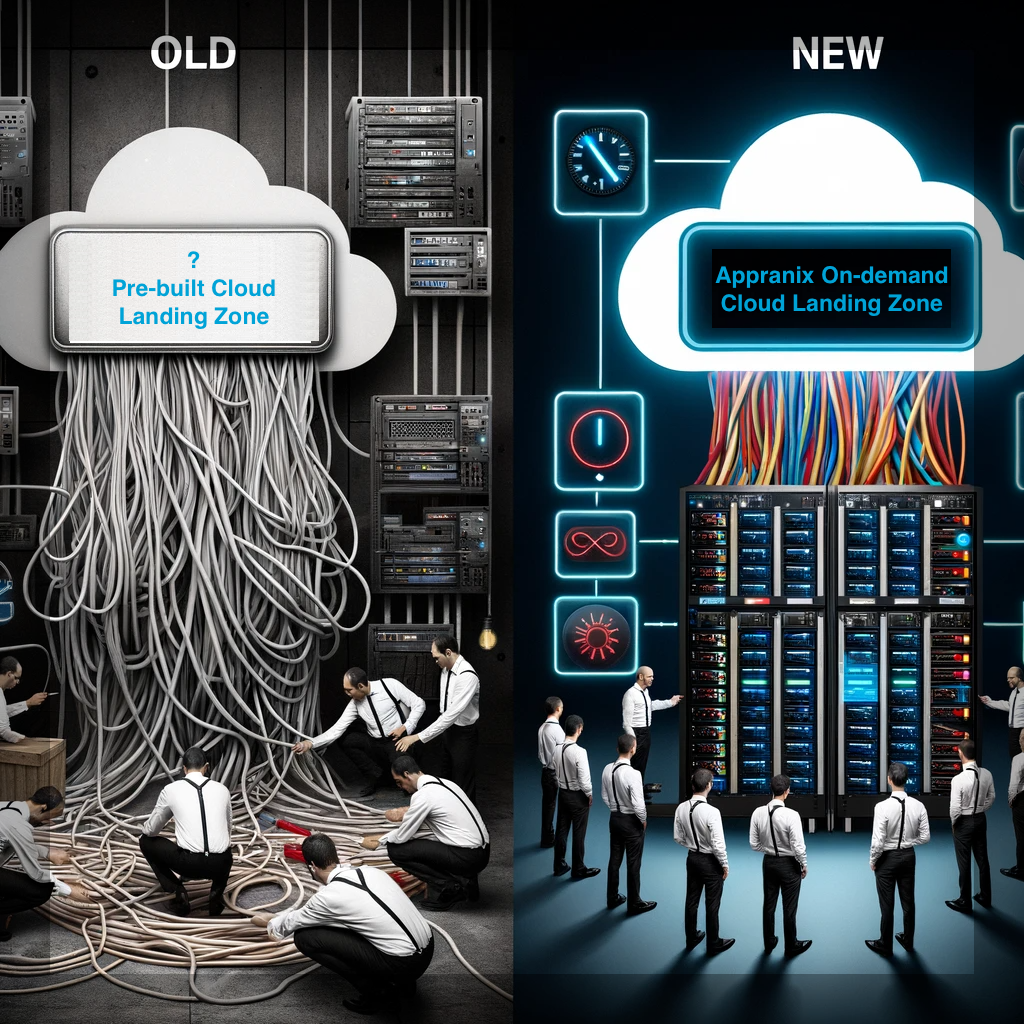In the dynamic landscape of cloud computing, organizations are increasingly reliant on robust disaster recovery strategies to ensure resilience and uninterrupted service delivery. One approach that has been traditionally adopted is the pre-creation of a cloud landing zone as part of a disaster recovery (DR) plan. However, this method is fraught with inefficiencies and potential pitfalls that can undermine its effectiveness and cost organizations time, resources, and operational resilience. This blog delves into the concept of a cloud landing zone, highlights the challenges associated with pre-creating such zones for disaster recovery, and introduces Appranix's rebuild model as a superior alternative for ensuring cloud resilience.

Understanding Cloud Landing Zones
A cloud landing zone is a pre-configured environment within a cloud account designed to manage cloud resources securely and efficiently. It provides a structured framework for cloud resource deployment, network configuration, and security settings, aligning with best practices and organizational policies. The intent is to facilitate smooth, scalable, and compliant cloud operations.
While cloud landing zones serve as the foundation for deploying and managing cloud resources, their application in disaster recovery scenarios presents several challenges.
Challenges with Pre-Created Cloud Landing Zones for Disaster Recovery
-
Time and Resource Consumption
Creating a DR-specific cloud landing zone requires a comprehensive understanding of the existing production environment's architecture and maintenance practices. This replication effort demands substantial time and resources, duplicating efforts and diverting them from value-generating activities. Moreover, the ongoing need to align the DR environment with the production environment compounds this challenge, leading to inefficiency and potential resource wastage.
-
Maintenance and Configuration Drift
Once established, a DR landing zone necessitates ongoing maintenance to ensure its alignment with the production environment. However, the dynamic nature of cloud environments often leads to configuration drift—a divergence in the settings and configurations between the production and DR environments. This drift complicates maintenance efforts and can compromise the efficacy of the DR strategy.
-
Impediments to Business Continuity Testing
The divergence between production and DR environments due to drift and misalignment hampers the ability of business continuity teams to conduct effective recovery testing. The hesitancy or inability to test recoveries undermines the resilience of IT systems, leaving organizations vulnerable in the event of a disaster or cyber attack.
-
Wasted Investments
The resources expended on creating and maintaining a pre-created DR landing zone can be substantial, yet the return on investment (ROI) is often minimal. Organizations may find themselves with outdated or misaligned DR environments that are not ready for immediate use following a disaster. Furthermore, in the face of sophisticated ransomware attacks, the ability to rebuild systems from clean data and application images is crucial—a capability that is hampered by the constraints of a pre-created landing zone.
The Appranix Rebuild Model: A Superior Approach to Cloud Resilience
Appranix's rebuild model for cloud resilience offers a more agile, efficient, and effective approach to disaster recovery. Unlike the traditional model of pre-creating and maintaining a DR landing zone, Appranix focuses on the ability to dynamically rebuild cloud environments from clean copies of data and application images. This model addresses the core challenges associated with pre-created landing zones:
-
Efficiency and Agility: By eliminating the need for a pre-created DR landing zone, organizations can allocate resources more efficiently, focusing on strategic initiatives rather than maintenance and alignment efforts.
-
Reduced Configuration Drift: The rebuild model mitigates the risk of configuration drift by ensuring that the recovery environment is constructed with the latest, clean configurations and data, closely mirroring the production environment at the time of rebuild.
-
Enhanced Testing and Recovery: The dynamic nature of the rebuild approach facilitates more frequent and realistic testing of disaster recovery procedures, enhancing IT system resilience.
-
Cost-Effectiveness: Without the sunk cost of maintaining a pre-created DR landing zone, organizations can achieve better ROI on their disaster recovery investments, focusing on rapid recovery capabilities that are more aligned with modern cloud practices.
Moreover, in the context of increasing cyber threats like ransomware, the ability to rapidly rebuild a clean environment is invaluable. The Appranix rebuild model ensures that organizations can swiftly respond to such threats, minimizing downtime and ensuring business continuity.
Conclusion
The traditional approach of pre-creating cloud landing zones for disaster recovery is fraught with inefficiencies, including wasted resources, maintenance challenges, and compromised resilience. In contrast, Appranix's on-demand rebuild model for cloud resilience offers a more agile, cost-effective, and robust solution. By focusing on the dynamic rebuild of cloud environments, pretty much a clone of the production environment, organizations can enhance their disaster recovery capabilities, reduce operational risks, and ensure continuous service delivery in the face of disruptions. The shift towards the rebuild model represents a forward-thinking approach to disaster recovery, aligning with the evolving demands of cloud computing and organizational resilience.
